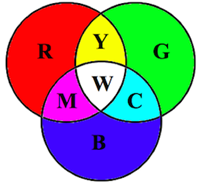Hold down the T key for 3 seconds to activate the audio accessibility mode, at which point you can click the K key to pause and resume audio. Useful for the Check Your Understanding and See Answers.
Mission LC4 Complementary Colors of Light - Question Group 9 Help

Three colored spotlights - red, green and blue - with equal intensities are used to shine white light upon a magenta shirt. The shirt appears magenta because it absorbs the ____ light and reflects the ____ light.

 Many students of physics have seen a diagram similar to the one shown at the right. The diagram depicts three circles colored with the primary colors of light - red, green and blue. The primary colored circles overlap to produce other colors of light - known as the secondary colors of light: cyan, magenta and yellow. Complementary pairs of light colors are those colors that are exactly opposite each other on the diagram: red and cyan, magenta and green, and blue and yellow.
Many students of physics have seen a diagram similar to the one shown at the right. The diagram depicts three circles colored with the primary colors of light - red, green and blue. The primary colored circles overlap to produce other colors of light - known as the secondary colors of light: cyan, magenta and yellow. Complementary pairs of light colors are those colors that are exactly opposite each other on the diagram: red and cyan, magenta and green, and blue and yellow.
An object that is observed to be a specific color when illuminated with white light has absorbed the complementary color of the observed color. White light or R+ G + B was incident on the object. One or more of the components of white light were absorbed or subtracted and the remaining light colors were reflected to the observer's eye.

The color of a shirt is not in the shirt itself, but rather in the light that the shirt reflects. If red, green and blue light shine on a shirt and the shirt appears magenta, then the red and blue light of red, green and blue incident light was reflected. After all, magenta light can be thought of as equivalent to red and blue. So if the red and blue was reflected, then what happened to the green light? It was subtracted or absorbed. So green is absorbed by a shirt that looks magenta. Now think about the color wheel shown in the Dig That Diagram section and you will see the big idea. Green light - the complement of magenta light - is absorbed when a shirt appears magenta in the presence of white light.
